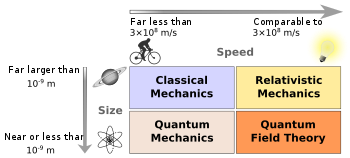| Domains of major fields of physics (Photo credit: Wikipedia) |
When Einstein first published his theory it had to go through years of refinement and testing. That is the process. There are still things being worked out with Darwin's Theory of Evolution but the days of wondering if it is valid are long behind us. It has been proven, observed, and tested. There are still evolutionary mechanisms to be worked out and the history of evolution will take more field work.
Looking at the history of theories, I am beginning to think that the discipline a given theory arises from is often the one least capable of evaluating it. But that is where all of the experimental and observational evidence is going to come from. Most of the criticisms I have read of Connectivism boil down to the new theory is not like the old theories. A theory is meant to provide a conceptual framework for viewing and understanding phenomena. As an instructional designer, I have a purely practical approach. I am only interested in a theory's usefulness, but for me, a theory must
- account for current theories (either through refutation or inclusion)? A theory shouldn't just account for a given phenomena, it should do so in some measurably better way (more complete, elegant, etc.).
- sufficiently explain where we are now.
- make predictions. Any theory that can't predict anything is basically a conjecture at best.
- be subject to testing. Here I would emphasize that the theory should change what we do based on experiment and empirical data.
 One of the problems of learning theory is that it is usually an interpretation of learning based on a psychological school of thought, sociology, or philosophy. It would be difficult for learning theory not to come from those disciplines, but learning theory seems to get stuck because while the derivative disciplines may have moved on, the learning theory often does not because educators are not participating or doing research in the parent disciplines.
One of the problems of learning theory is that it is usually an interpretation of learning based on a psychological school of thought, sociology, or philosophy. It would be difficult for learning theory not to come from those disciplines, but learning theory seems to get stuck because while the derivative disciplines may have moved on, the learning theory often does not because educators are not participating or doing research in the parent disciplines.
New theories come about when the current theories no longer account for new information or phenomena. This is what made Connectivism particularly important to my work. The theory was created by Stephen Downed and George Siemens (Connectivism: a learning theory for the digital age) at the same time that networks and social media were impacting education in some profound ways. Some of the phenomena that Connectivism accounts for are phenomena that many educators fight against: online classes, social media, MOOCs, student-driven learning, etc. Connectivism for these instructors will never be a valid theory because they will never be comfortable with some of the implications of the theory: it would represent a profound change in their world view that they are not ready to accept. Connectivism is a learning theory because it accounts for the changes we are seeing in our society and in education in ways that the older theories cannot. Even social constructivists have a hard time wrapping their minds around social networks.
With that said, I am no ideologue either. I have my own bones to pick with Connectivism. It is still unclear to me how learning "may reside in a non-human appliance." It should either be the case or not. My definition of learning requires someone to actually do the learning. I see non-human appliances storing information, processing information, even mimicking pattern-making (chess computers). I don't understand how learning resides there. That is my "why a duck?" moment with the theory. It also feels like a left over principle from another theory that is not necessary for Connectivism to be a strong theory on its own.
But Connectivism is not just an explanatory or descriptive theory. As an instructional designer, I can use it to help analyze the success and failure of a particular course. So how would I test it? There are a number of ways. First, we build a course design rubric based on the tenets of Connectivism, and compare the success and retention rates, and course satisfaction (for students and teachers). Second, we repeat the experiment, and share the finding so others can reproduce the results.
The jury is still out for Connectivism. This is as it should be! The jury should always be out for all theories if we are going to engage in the scientific method and reason together.


What I see missing in this learning theory is cognitive science.
ReplyDelete"Cognitive science" is a huge field with lots of things left undefined and as yet to be resolved issues. There is also a lot of attention paid to cognitive science in the writings on connectivism by both George Siemens and Stephen Downes. Here is my take on cognitive science and education: http://cain.blogspot.com/2014/04/connectivism-neuroscience-and-education.html
ReplyDeleteIndeed connectivism is a theory. Back to the basics a theory is an intelligence guess- it is convincing and you have no basis of proving otherwise- that is why refinements may be suggested by others
ReplyDelete